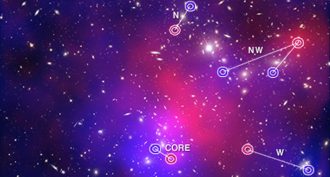HS-ESS1-2
Construct an explanation of the Big Bang theory based on astronomical evidence of light spectra, motion of distant galaxies, and composition of matter in the universe.
-
 Planets
PlanetsDouble sunsets on a distant world
Astronomers discover for the first time a planet circling two stars.
-
 Space
SpaceThe dark side of the universe
Most of the cosmos is invisible, but that doesn’t stop scientists from searching for it.
-

-
 Space
SpaceBlack hole journey
Research on weird, invisible objects called black holes might help explain how the universe began.
By Emily Sohn -
 Space
SpaceBaby star
Astronomers have observed the earliest twinkles ever picked up from a newborn star.
By Emily Sohn -
 Planets
PlanetsA very distant planet says “cheese”
A small red spot may be the first picture ever taken of a planet outside the solar system.
By Emily Sohn -
 Space
SpaceSearching for alien life
A robot rover practices looking for alien life by trekking across the world's driest desert.
By Emily Sohn -
 Space
SpaceBurst busters
A powerful type of explosion in outer space is much more common, but not always as powerful, as astronomers had thought.
By Emily Sohn -
 Planets
PlanetsCatching a Comet’s Tail
A closeup visit by a NASA spacecraft helps show how a comet gets its shape.
-
 Planets
PlanetsA planet from the early universe
Astronomers have found the oldest and most distant planet known in the universe.
By Emily Sohn -
 Space
SpaceA galaxy far, far, far away
Astronomers have glimpsed some of the most distant galaxies yet found.
By Emily Sohn -
 Space
SpaceBlack holes that burp
Some black holes in outer space may actually spit out as much material as they suck in.
By Emily Sohn